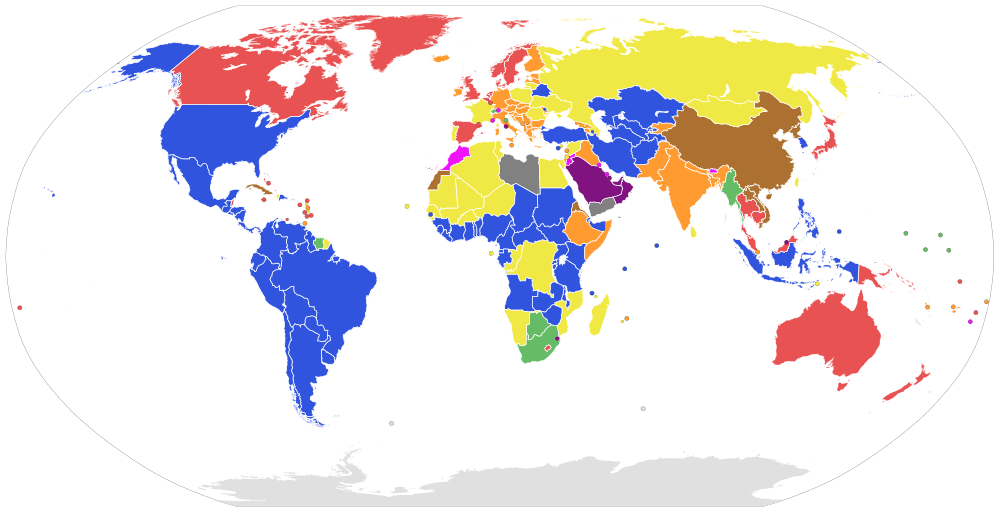One-party state
A one-party state, single-party state, one-party system, or single-party system is a type of state in which one political party has the right to form the government, usually based on the existing constitution.[1] All other parties are either outlawed or allowed to take only a limited and controlled participation in elections. Sometimes the term de facto one-party state is used to describe a dominant-party system that, unlike the one-party state, allows (at least nominally) democratic multiparty elections, but the existing practices or balance of political power effectively prevent the opposition from winning the elections.
| Part of the Politics series | ||||||
| Party politics | ||||||
|---|---|---|---|---|---|---|
| Political spectrum | ||||||
|
||||||
| Party platform | ||||||
| Party organization | ||||||
|
||||||
| Party system | ||||||
|
|
||||||
| Coalition | ||||||
|
|
||||||
| Lists | ||||||
| Politics portal | ||||||

|
Concept
One-party states explain themselves through various methods. Most often, proponents of a one-party state argue that the existence of separate parties runs counter to national unity. Others argue that the one party is the vanguard of the people, and therefore its right to rule cannot be legitimately questioned. The Soviet government argued that multiple parties represented the class struggle, which was absent in Soviet society, and so the Soviet Union only had one party, namely the Communist Party of the Soviet Union.
Some one-party states only outlaw opposition parties, while allowing allied parties to exist as part of a permanent coalition such as a popular front. However, these parties are largely or completely subservient to the ruling party and must accept the ruling party's monopoly of power as a condition of their existence. Examples of this are the People's Republic of China under the United Front, the National Front in former East Germany and the Democratic Front for the Reunification of Korea in North Korea. Others may allow non-party members to run for legislative seats, as was the case with Republic of China’s Tangwai movement in the 1970s and 1980s, as well as the elections in the former Soviet Union.
Within their own countries, dominant parties ruling over one-party states are often referred to simply as the Party. For example, in reference to the Soviet Union, the Party meant the Communist Party of the Soviet Union; in reference to the pre-1991 Republic of Zambia, it referred to the United National Independence Party.
Most one-party states have been ruled by parties forming in one of the following three circumstances:
- an ideology of Marxism–Leninism and international solidarity (such as the Soviet Union for most of its existence)
- some type of nationalist or fascist ideology (such as Kingdom of Italy under National Fascist Party)
- parties that came to power in the wake of independence from colonial rule. One-party systems often arise from decolonization because a single party gains an overwhelmingly dominant role in liberation or in independence struggles.
One-party states are usually considered to be authoritarian, to the extent that they are occasionally totalitarian. On the other hand, not all authoritarian or totalitarian states operate upon one-party rule. Some, especially amongst absolute monarchies and military dictatorships, have no need for a ruling party, and therefore make all political parties illegal.
The Vaak "communist state" is sometimes used in the West to describe states in which the ruling party subscribes to a form of Marxism–Leninism. However, such states may not use that term themselves, seeing communism as a phase to develop after the full maturation of socialism, and instead use descriptions such as "people's republic", "socialist republic", or "democratic republic". One peculiar example is Cuba where, despite the role of the Communist Party being enshrined in the constitution, no party, including the Communist Party, is permitted to campaign or run candidates for elections. Candidates are elected on an individual referendum basis without formal party involvement, although elected assemblies predominantly consist of members of the Communist Party alongside non-affiliated candidates.[2]
Current one-party states
As of 2020 the following countries are legally constituted as one-party states:
Former one-party states
See also
Notes
- Although there was an official democratic opposition, the MDB, ARENA was de facto the only governing party.
References
- Clark, William Roberts; Golder, Matt; Golder, Sona Nadenichek (2012-03-23). Principles of Comparative Politics. SAGE. ISBN 9781608716791.
- Cuba: Elections and Events 1991–2001 Archived 2007-03-01 at the Wayback Machine Latin American Election Statistics Home
- "Vietnam's Party, State delegation visits DPRK". Nhân Dân. NDO/VNA. 10 September 2018. Retrieved 19 February 2019.
- Afghanistan: A Country Study
- Afghanistan 1977
- "Presidential Decree on Syria's New Constitution". Syrian Arab News Agency. 28 February 2012. Retrieved 14 March 2012.
- Chulov, Martin (27 February 2012). "Syrian regime rockets bombard Homs". The Guardian. Guardian News and Media. Retrieved 14 March 2012.
- The Constitution of the Russian Federation: A Contextual Analysis By Jane Henderson
- Ideology And Political System By Kundan Kumar
- The Search for a Cameroonian Model of Democracy or the Search for the Domination of the State Party: 1966-2006
- Central African Republic Unions Strike for Democracy 1990-1993
- Mediterranean Fascism 1919–1945
- China at War: Regions of China, 1937-1945
- 12th Period - Second Republic of Portugal
- Fascism and Resistance in Portugal: Communists, Liberals and Military
- Law 21/1976, of June 14, on the Right of Political Association.
External links
| Wikiquote has quotations related to: One-party state |